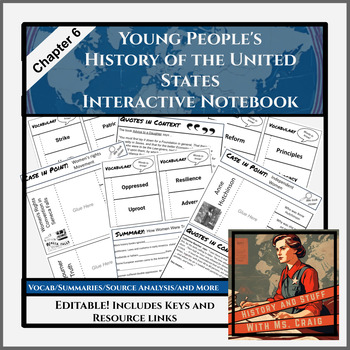Young People's History of the United States, Chapter 6: Interactive Notebook
History and Stuff with Ms Craig
24 Followers
Grade Levels
5th - 11th, Homeschool
Resource Type
Standards
CCSSCCRA.R.1
CCSSCCRA.R.2
CCSSCCRA.R.3
CCSSCCRA.R.4
CCSSCCRA.R.5
Formats Included
- Google Slides™
Pages
23 pages
History and Stuff with Ms Craig
24 Followers

Made for Google Drive™
This resource can be used by students on Google Drive or Google Classroom. To access this resource, you’ll need to allow TPT to add it to your Google Drive. See our FAQ and Privacy Policy for more information.
Also included in
- "Young People's History of the United States EDITABLE Interactive Notebook U.S. History" – an engaging and dynamic educational resource designed to make learning U.S. history a memorable and interactive while introducing learners to Howard Zinn's classic text.This resources includes Chapter 1-5. ThiPrice $25.00Original Price $35.00Save $10.00
Description
"Young People's History of the United States "Young People's History of the United States EDITABLE Interactive Notebook U.S. History" – an engaging and dynamic educational resource designed to make learning U.S. history a memorable and interactive while introducing learners to Howard Zinn's classic text.
This resources focuses on Chapter 6: The Women of Early America.
Includes Resources for
- Vocabulary
- Summary
- "Case in Point"- focused case studies
- Quote analysis- from both primary and secondary sources
- Timelines
- Chapter test
There are 12 pages of activities, plus a complete answer key.
All text in the unit is editable. Teachers can edit the topics and questions so they better fit the lessons.
Total Pages
23 pages
Answer Key
Included
Teaching Duration
40 minutes
Report this resource to TPT
Reported resources will be reviewed by our team. Report this resource to let us know if this resource violates TPT’s content guidelines.
Standards
to see state-specific standards (only available in the US).
CCSSCCRA.R.1
Read closely to determine what the text says explicitly and to make logical inferences from it; cite specific textual evidence when writing or speaking to support conclusions drawn from the text.
CCSSCCRA.R.2
Determine central ideas or themes of a text and analyze their development; summarize the key supporting details and ideas.
CCSSCCRA.R.3
Analyze how and why individuals, events, and ideas develop and interact over the course of a text.
CCSSCCRA.R.4
Interpret words and phrases as they are used in a text, including determining technical, connotative, and figurative meanings, and analyze how specific word choices shape meaning or tone.
CCSSCCRA.R.5
Analyze the structure of texts, including how specific sentences, paragraphs, and larger portions of the text (e.g., a section, chapter, scene, or stanza) relate to each other and the whole.






